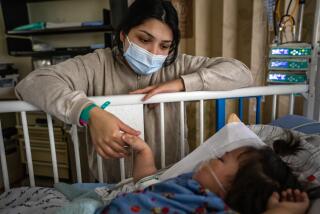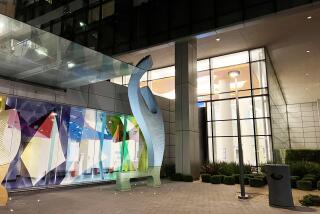Baby With Flesh-Eating Bacteria Critical but Stable
- Share via
NORTHRIDGE — An 11-month-old Oxnard girl fought for life in a pediatric intensive care unit Tuesday, her body ravaged by flesh-eating bacteria.
After removing strips of dead tissue from her chest and back, surgeons began grafting cadaver skin to her tiny frame Tuesday afternoon in hopes of staving off fatal infection.
“This is a tragedy,” said plastic surgeon Stephen Bresnick, the pediatric specialist leading the surgical team at Northridge Hospital Medical Center. “This child has lost 20% of her skin. She’s lost muscle. She’s lost fat. Her ribs are exposed.”
The girl, identified only as Baby Rosa, remained on life support and massive doses of antibiotics Tuesday. She was listed in critical but stable condition. Doctors said she was improving, but cautioned that only about half of patients with such severe cases of flesh-eating bacteria survive.
Doctors remain mystified about how Rosa contracted the deadly condition, but believe it sprang from a simple staph infection--Staphylococcus aureus, the same bacteria that causes boils and other relatively harmless skin conditions.
Baby Rosa’s parents, who live in Oxnard, told hospital officials they did not wish to be identified. They did not attend a press conference on the little girl’s case held at the hospital Tuesday.
Her parents first noticed something wrong June 30, when Rosa came down with a mild fever. Rosa’s mother took her to a doctor in Oxnard, who took a throat culture and sent the girl home, said Dr. Hooshang Semnani, head of pediatric critical care at the Northridge hospital. Semnani said he did not know the identity of the Oxnard physician.
On July 1, Rosa’s mother drove her to Mexico to see a family doctor in Tijuana. After spotting a bright red rash developing on the girl’s back, the doctor told Rosa’s mother to immediately drive back to Los Angeles and check her into a hospital, Semnani said.
Rosa arrived at Ventura County Medical Center on Thursday afternoon with a 104-degree temperature and a severe rash covering most of her back, Semnani said. She was in shock. Emergency room doctors diagnosed her problem as flesh-eating bacteria--necrotizing fasciitis, a potentially fatal condition. Thursday night, surgeons removed part of the baby’s right side, back and chest to rid her body of the rapidly moving bacteria, Semnani said.
On Friday morning, Rosa was transferred to the Northridge hospital, where doctors stabilized her in a hyperbaric unit, an oxygen-rich chamber that stimulates the body’s immune system and accelerates healing. Doctors also drained three previously undiscovered abscesses containing the bacteria.
“It is really the host, the baby in this case, who is not handling what should be an easy-to-handle infection,” said Dr. John Alexander, head of hyperbaric and pulmonary medicine for the hospital. “Why this occurs . . . we don’t know all the answers. When it does, these infections grow extremely rapidly.”
On Tuesday afternoon, a team of doctors began grafting 77.5 square inches of cadaver skin over Rosa’s open wound, a temporary sheath to prevent infection until enough of the baby’s own skin can be harvested from healthy areas of her body, Bresnick said.
Treating such a wound is similar to the treatment for a burn victim, he said. Treating Rosa will be especially difficult, however, because her tiny body has little healthy skin to spare.
If she survives, Rosa will probably undergo a series of complicated and costly operations to repair the damage and still will be left with a significant deformity, Bresnick said.
“You can picture almost a shark-bite deformity,” Bresnick said.
The flesh-eating disease can be caused by a number of virulent bacteria able to penetrate deep into the body. The bacteria cause blood vessels to collapse, choking off the flow of blood and killing oxygen-starved tissue.
An estimated 500 to 1,500 cases of necrotizing fasciitis are diagnosed every year in the United States, and about one out of every five patients dies, according to the Centers for Disease Control and Prevention in Atlanta.
Rosa’s parents do not have health insurance, said hospital spokeswoman Toshia D. Johnson. The baby’s doctors and the Northridge hospital said they will provide care regardless, and later seek reimbursement for covered expenses from Medi-Cal. Northridge Hospital Medical Center administrators estimate Rosa has received more than $100,000 in medical care at their institution alone.
The hospital’s press conference was held on the same day health officials told the Los Angeles Board of Supervisors they have confirmed allegations that a doctor at Northridge Hospital Medical Center demanded cash from a Medi-Cal patient before providing epidural anesthesia during childbirth. The county district attorney is reviewing the case for possible prosecution.
Hospital officials bristled at the suggestion they may be using the Baby Rosa case to deflect news reports about the investigation.
“This is not a publicity stunt,” Johnson said. “This is a tragedy. The family wanted to let people know about this condition.”
(BEGIN TEXT OF INFOBOX / INFOGRAPHIC)
The Treatment of Baby Rosa
Flesh-eating bacteria destroyed about 77 square inches of skin on Baby Rosa’s chest, side and back before physicians were able to halt its spread. Muscles and other tissues were also affected. Surgeons have grafted cadaver skin over her wounds to help stave off potentially fatal infections.
*
Symptoms
Swelling
Pain
Fever
*
Treatment
Removal of dead tissue
Skin graftsHyperbaric chamber
*
What happens
Bacteria destroys tissue
Inflamation sets in
Tissue dies within few days.
Sources: Centers for Disease Control
More to Read
Sign up for Essential California
The most important California stories and recommendations in your inbox every morning.
You may occasionally receive promotional content from the Los Angeles Times.














